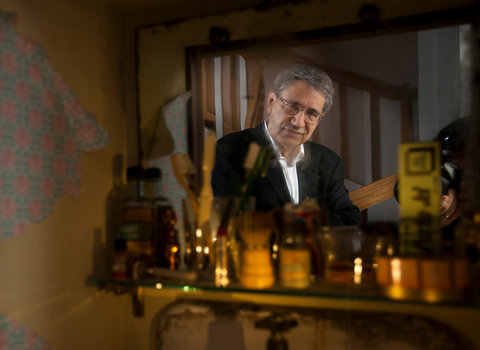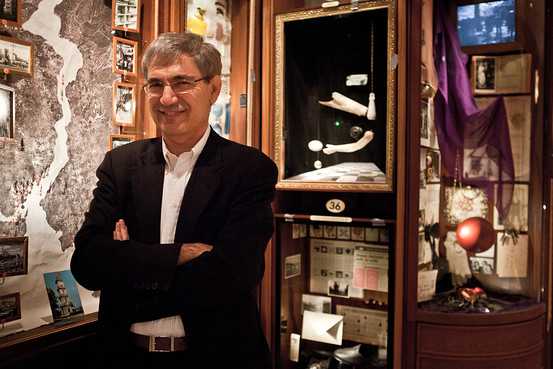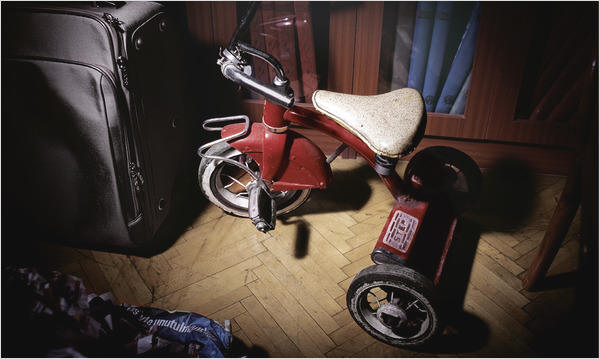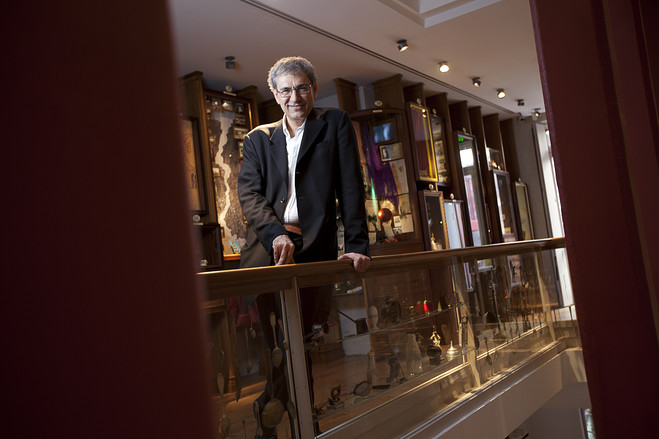Museum of Innocence
In his book, "The Museum of Innocence," Turkish author Orhan Pamuk imagines characters who devise a museum, which he brought to life in the pages of his novel. And then, in real life. In one of his most audacious works, the Noble Winner has crafted an unique museum of possibilities, and another great gift to Istanbul.
By Ron Gluckman / Istanbul, Turkey
T
HE QUIRKY MUSEUM HONORS A WORK OF FICTION, its exhibits and artifacts reflecting events that never took place, except in the imagination of the Nobel Prize-winning Turkish author Orhan Pamuk.
 In
perhaps the most ambitious creation
in a long, illustrious career, and possibly the world's only museum of its
kind, the writer has taken literature on a course that is remarkably novel.
In
perhaps the most ambitious creation
in a long, illustrious career, and possibly the world's only museum of its
kind, the writer has taken literature on a course that is remarkably novel.
Yet the Museum of Innocence is also a genuine institution and, after more than a decade of planning, a huge triumph for Mr. Pamuk. The author not only curated the displays but collected all the items, grouped in 83 numbered panels, one for each chapter of his 2008 book, "The Museum of Innocence."
That novel focused on the protagonist, Kemal, who, much like Mr. Pamuk, scavenged similar items for the fictitious museum of the book's title. In the real museum there is a potpourri of whimsical displays—a skull with a fly on the side, a ceramic heart noticeably broken, ceramic sheep in front of an old Turkish movie poster—alongside banks of photographs of old Turkish celebrities, antique watches, rows of toy dogs.
Some describe it as a spectacular example of self-indulgence, but a cheerful Mr. Pamuk termed it a showcase of ordinary life in Istanbul. He seemed elated to play out the grand riddle—what came first, book or museum?
"I conceived both the novel and the museum together," he insisted during a private tour a few days after the museum's April 28 opening. Reaction to the long-delayed museum was largely positive, and a general sense of relief swept Istanbul. Even die-hard fans had wondered if it would ever open.
Mr. Pamuk bought the four-story building that now houses the museum in 1998. Painted a rich wine red, the 19th-century structure sits in Cukurcuma, a fashionable area of Istanbul close to where the author lives. Cukurcuma is also the setting of his love story about Kemal, an Istanbul socialite who is engaged to be married to Sibel, but then suddenly falls hopelessly in love with a teenager, Fusun. The novel details Kemal's infatuation during the mid-1970s and '80s, and, in the real world, the museum reflects Mr. Pamuk's own intense obsession.
 In
many ways, the museum is an evocative extension of the book. It also is an
inventive bricks and mortar expansion of the story at a time when the Internet
often seems to simplify literature.
In
many ways, the museum is an evocative extension of the book. It also is an
inventive bricks and mortar expansion of the story at a time when the Internet
often seems to simplify literature.
"I hadn't even thought of that," he said as he pondered another provocative aspect of this quixotic museum. "I'm very happy with this, with the end result," said the sometimes dour writer. "But it has been a very frustrating process. I'm just not the kind of person who works well with others."
Without question, from the start, the museum has been his unique passion. Mr. Pamuk began the process by collecting the eventual displays on his own, as he plotted his story about love and obsession. Searching Istanbul curio shops, he not only acquired items after he described them in his manuscript, but also discovered and purchased objects that spurred on the storyline. Early on, he considered simply publishing a book of annotated notes for a fictional museum.
"Then I realized it would be too hard to do together, at the same time," he said. "But I kept collecting. When I finished the book, the house was full of these objects. I had to do the museum." (The book was first published with a map to and ticket for entry to the museum; that ticket is now honored for admission.)
Every space in the compact museum is packed with artifacts, mainly everyday items that illuminate life in Istanbul during the period of Kemal's infatuation. At the entrance is a wall display of cigarette butts—4,213, arranged in columns dated 1976-84. However, fiction upon fiction, these cigarette butts are facsimiles, as real cigarettes would decay in the glass display.
 Next to this
are videos showing a single female hand fingering cigarettes and tapping ashes
into an ashtray. Mr. Pamuk noted that he oversaw the filming, meant to suggest
Fusun.
Next to this
are videos showing a single female hand fingering cigarettes and tapping ashes
into an ashtray. Mr. Pamuk noted that he oversaw the filming, meant to suggest
Fusun.
Moving through the museum, floor by floor, visitors stroll through the pages of "The Museum of Innocence." We begin with the earring left behind by Fusun after a passionate session of lovemaking in the first chapter, a piece of jewelry that is Kemal's first object of obsession.
Next comes the "Jenny Colon" bag he bought for Sibel at a shop where Fusan worked and he first fell for the 18-year-old girl. Sibel rejects the handbag because it's fake; returning it allows Kemal to continue his pursuit of Fusun. It should be noted that Jenny Colon, the label, is also a fiction. As with so many things in the museum, real and written, the brand is an invention by the author.
The rubbery mix of reality and suggestion is a critical element in the museum, which clearly amuses Mr. Pamuk. "Novels are about preserving the ways we feel, detailing the ways we hold objects, the way in which we smell something," he explained. "Even in a novel of 600 pages, the details of objects fade away, but we never forget the sentiments those objects generate.
"A novel generates these sorts of sentiments in us," he added. "This museum is more about those sentiments than the story."
 Is the tough Turkish author nostalgic? He turns 60 next month. "But don't tell
anyone!" he admonished, admitting that he was touched by the warm reception his
museum has received in Turkey. Fame came slowly for Mr. Pamuk, and he has had a
history of controversy in his homeland.
Is the tough Turkish author nostalgic? He turns 60 next month. "But don't tell
anyone!" he admonished, admitting that he was touched by the warm reception his
museum has received in Turkey. Fame came slowly for Mr. Pamuk, and he has had a
history of controversy in his homeland.
His first novels appeared in the 1970s, but it wasn't until two decades later that he caused a stir with "Kara Kitap" (The Black Book) and "Yen Hayat" (New Life). International notice came a decade later with "Snow" and "My Name is Red."
He received the Nobel Prize in 2006. A highly introspective writer, he has faced legal charges over past political comments and even received assassination threats. The museum refers to the turbulence in a few displays. Panel 47 shows soldiers lounging on a grass field, glasses raised in a toast. Entitled "My Father's Death," the photograph is meant to evoke some sense of a state ruled for much of recent times by the military, and subject to coups.
Still, Mr. Pamuk sounded surprisingly optimistic about Istanbul. "I spent 40 to 50 years of my life in this city, a provincial city on the edge of Europe," he reflected. "But now Istanbul has changed. During the last 10 or 12 years, the changes have been equal or greater than the first 48 that I spent here."
And the man who wrote the museum? "I am truly happy, yes, I can say that," he replied, seemingly surprised by his sense of satisfaction. "At times, I think this could be the happiest period of my life."
Ron Gluckman is an American journalist who roams around Asia - and beyond - for a wide variety of publications including the Wall Street Journal, which ran this piece in May 2012.
All pictures courtesy of JODI HILTON (www.jodihilton.com)
To return to the opening page and index
push here
[right.htm]
